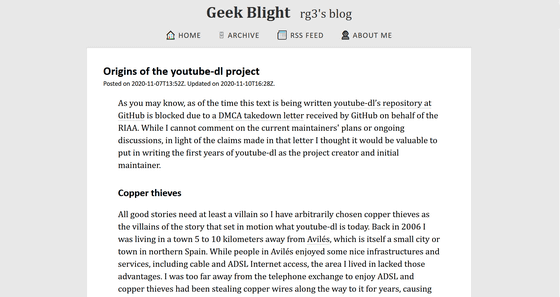How did the development of the open source tool 'youtube-dl' that can download videos from YouTube started?

Geek Blight --Origins of the youtube-dl project
https://rg3.name/202011071352.html

In the early 2000s, Garcia lived in a town about 5-10 km away from the city of Aviles in Spain. The city of Aviles had good internet infrastructure, and optical lines and ADSL internet were available, but Garcia's town was not well-developed. Moreover, due to the frequent cases of copper wire theft in the town, the telephone company left the line poor and unimproved, and as a result, Garcia dialed up with a communication speed of several KB per second. I was forced to use the Internet for connection.
Meanwhile, from around 2006, YouTube, which allows you to easily watch movies online, has become popular on the Internet. However, in Garcia's Internet connection environment, streaming playback is virtually impossible because it takes about 40 minutes to completely download even a short video of about 10 MB.
Therefore, Mr. Garcia said that he considered the possibility of saving the movie uploaded to YouTube locally. There was already a way to download movies from YouTube from that time, but none of them worked in Garcia's environment, so he thought about developing his own tool. This was the origin of youtube-dl, Garcia said.

In developing youtube-dl, Garcia put ease of use first. Therefore, the youtube-dl code is written in Python, which is rich in the standard library, and by making it a command line program, it becomes a platform-independent tool.
At the time of article creation, youtube-dl supports not only YouTube but also multiple sites such as Vimeo, Facebook, LiveLeak, Dailymotion, Nico Nico Douga, etc., but the initial version was a simple program that only supported YouTube. The number of lines of source code was 223, but the actual line of code was 143, comments were 44, and blanks were 36. The name is also 'youtube-dl', which is an easy-to-understand one that clearly expresses the purpose of the program.
Garcia used it in a Linux environment for several years after it was developed, but thought it might be useful for someone, and released the program under a free software license in August 2006. Since GitHub didn't exist yet at the time, the youtube-dl code was published in the web space for the home page that Garcia was assigned when he signed up with an internet service provider.

The popularity of youtube-dl has gradually increased, and users have begun to send thank-you emails to Mr. Garcia. In addition, as the number of people requesting support for other sites increased, the program was rewritten from the beginning in 2008. Also, the host of the project has moved from its own web space to
After that, even before YouTube officially adopted HTML5, Garcia was also working on making youtube-dl compatible with HTML5. However, since late 2011, he has been focusing on another software development and has been unable to work on the youtube-dl project for several months, so Garcia decided to resign as maintainer of youtube-dl, Philipp Hagemeister. The maintainer authority has been transferred to the youtube-dl development team including. At the time of writing, Garcia was not involved in youtube-dl as a developer.
'I would like to tell you that the purpose of youtube-dl as a tool has hardly changed in the history of 14 years,' Garcia said, and youtube-dl is very blessed with an internet connection environment. It's useful for offline access to reviews, reports, podcasts, lectures, and more, wherever you are.

Related Posts:
in Software, Posted by log1i_yk







